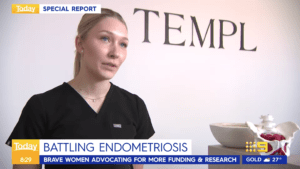As a mother of one, I know and sympathise fully with the trials and tribulations that come with having a child, both mental and physical. Postpartum recovery is not an easy walk in the park. Despite this, the experience has made me all the more passionate about helping women improve their intimate health and wellness, especially those who suffer from conditions such as urinary incontinence, prolapse, and endometriosis.
These are common issues that affect millions of women worldwide, but they are often ignored or dismissed as normal consequences of childbirth or aging. As such, it has made me realise more so than ever the importance of having founded TEMPL Body Co and how rewarding the journey has been so far.
In recent exciting news, I was thrilled to be invited on the Today Show Australia last week to spread the word that there are treatments out there for women and they do not have to suffer in silence.

Of the many excellent treatments that can drastically improve the quality of life of women, the treatment that has me most excited is BTL EMSELLA. This state-of-the-art breakthrough device uses electromagnetic stimulation to strengthen the pelvic floor muscles and improve blood circulation.
In addition to treating urinary incontinence and organ prolapses, BTL EMSELLA is lesser known for its ability to potentially reduce the pain and discomfort caused by endometriosis by relaxing the pelvic muscles and relieving pressure on the nerves. It is an unsung treatment that can be life-changing for some women. This is one of the issues I covered on the Today Show Australia last week and what I’ll be discussing in detail today.
What is Endometriosis?
But what is endometriosis exactly? Despite the multitude of myths and misinformation on the internet, endometriosis is not just some painful cramp that you get during your periods. Rather, something more serious is going on. Endometriosis is a condition where tissue similar to the lining of the uterus grows outside the uterus, causing pain and inflammation.
The symptoms of endometriosis may include pelvic pain, heavy periods, painful sex, infertility, and bowel or bladder problems. Endometriosis typically affects the ovaries, fallopian tubes, and the tissue lining the pelvis. In rare cases, it may spread beyond the pelvic organs and cause numerous other complications.
One of the major challenges of endometriosis is the lack of awareness of this disease by the general public and even front-line healthcare providers, despite being more common than many assume, globally affecting roughly 10% of women and girls of reproductive age. As a consequence, this often leads to significant delays in diagnosis.
Early treatment is crucial as it can slow or halt the natural progression of endometriosis and reduce its long-term symptoms. For this very reason, being given the opportunity to publicly shed light and raise awareness about this rarely discussed disease on the news last week was extremely important to me.
How is Endometriosis Treated?
The cause of endometriosis is unclear, nor is there a known way to prevent it. And so it comes down to treating it.
Endometriosis can be treated with medication, surgery, or a combination of both. The treatment depends on the severity of the condition, the patient’s age, and their fertility goals. However, some women may not find relief from conventional treatments or may experience side effects or complications.
Hormonal treatments can be used to suppress the normal menstrual cycle and in turn stop and/or slow endometriosis growth. These come in multiple forms including contraceptive pills, intrauterine devices, implants, and injections. These work by ‘turning off’ the body’s natural hormone production, in turn inducing ‘menopause-like’ symptoms such as hot flashes, night sweats, metabolism and emotional changes which can significantly impact one’s daily life.
More severe cases of endometriosis often result in surgery to remove endometriosis lesions, adhesions, and scar tissues. But this comes with the risk of infection as well as long recovery periods.

The Science of Treating Endometriosis with EMSELLA
This is where BTL EMSELLA comes in.
BTL EMSELLA is a non-invasive device that looks like a comfortable ergonomic chair. You simply sit on it fully clothed and let it do its magic.
The device emits high-intensity focused electromagnetic (HIFEM) waves that penetrate deep into the pelvic floor muscles and cause them to contract thousands of times per session. These contractions help restore the strength and tone of the pelvic floor muscles, which may improve bladder control and sexual function. They also help increase blood flow and oxygen delivery to the pelvic organs, which may reduce inflammation and pain.
BTL EMSELLA is FDA-cleared for treating urinary incontinence in both men and women, but it may also have benefits for women with endometriosis. According to a recent study published in the Journal of Women’s Health Care, BTL EMSELLA improved pain scores, quality of life scores, and sexual function scores in women with endometriosis after six sessions. The study also found that BTL EMSELLA was well-tolerated and had no adverse effects.
Looking broader, a systematic review of 81 studies on HIFEM therapy for patients with chronic pelvic pain (endometriosis included) concludes and reinforces that electromagnetic stimulation is effective at reducing pain stemming from pelvic area complications.
Compared to other treatments, BTL EMSELLA is a fantastic alternative for treating endometriosis as it is non-invasive and safe. There are no risk of infections and no downtime, and thus the treatment will have no impact whatsoever on patients’ everyday life. With BTL EMSELLA, endometriosis can be treated without it feeling like a hindrance.
The Treatment
What’s Involved?
Depending on the treatment area, a course of around 6-8 initial treatments (2 per week) is required before significant changes can be seen. Each treatment is 28 minutes long and you remain fully clothed. During the treatment, you will feel a slight tingling and vibrations in your pelvic floor muscles that will then turn into full contractions. This will be completely comfortable and tolerable. Take this 30 minutes to read a magazine or catch up on some Netflix.
Preparation and Aftercare
There is no downtime with BTL EMSELLA and you can get back to daily activity immediately following the procedure.
Maintenance
Maintenance is required 3 months after the initial course – this varies depending on the severity of endometriosis. We book you in for a follow-up appointment to ensure you maintain results and continue to enjoy the freedom and benefits.
Sharing the Benefits of EMSELLA with You
What’s more, the most remarkable thing about BTL EMSELLA is that it can be used to effectively treat a wide variety of concerns and conditions. Whether you’re a mother recovering from postpartum consequences or a man suffering from sexual dissatisfaction, BTL EMSELLA can help. At TEMPL, we offer treatments with BTL EMSELLA for urinary incontinence, organ prolapses, and erectile dysfunction.
Because I’m so impressed by the results of BTL EMSELLA, I want to share it with as many women as possible. That’s why we offer women one complimentary treatment using EMSELLA at our clinic, allowing you to try the power of this groundbreaking technology for yourself.

Founder & Head Clinician


